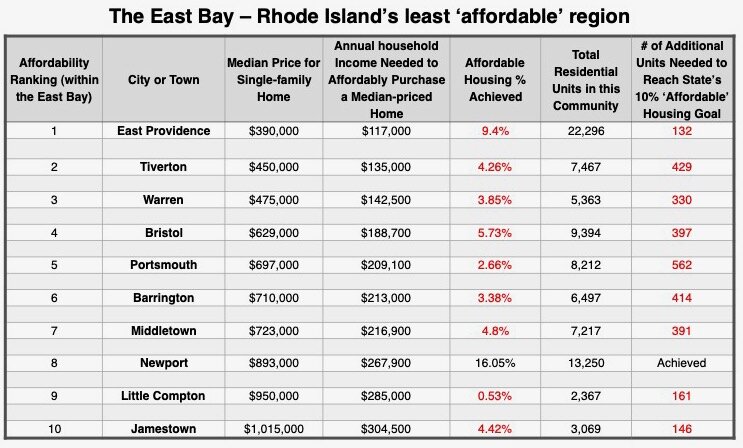- SATURDAY, JULY 27, 2024
‘David vs. Goliath’ – the East Bay and the affordable housing fight
It’s easy to see why our children and public servants can’t buy houses here
Shown here are the “affordability” metrics for the communities in the East Bay of Rhode Island. East Providence leads the way with the highest affordabilty ranking in the region, and it …
This item is available in full to subscribers.
Please log in to continue |
Register to post eventsIf you'd like to post an event to our calendar, you can create a free account by clicking here. Note that free accounts do not have access to our subscriber-only content. |
Day pass subscribers
Are you a day pass subscriber who needs to log in? Click here to continue.
‘David vs. Goliath’ – the East Bay and the affordable housing fight
It’s easy to see why our children and public servants can’t buy houses here
The lack of affordable housing in Rhode Island is acute and even more so in the East Bay area. With seven East Bay towns having the highest median sale prices of the 39 cities and towns, it is easy to understand why the region lacks affordable housing.
Rhode Island’s Low & Moderate Income Act, which was enacted in 1991, requires that at least 10 percent of the housing supply in each municipality be classified as affordable to residents with varying income levels.
The accompanying chart shows just how dire affordable housing is in the East Bay area. Of the ten cities and towns listed, only Newport has achieved the state-mandated 10 percent goal required by the law. East Providence is on the verge of meeting the 10 percent goal, Bristol is next in line with 5.73 percent, followed by Middletown at 4.8 percent.
Little Compton is at an anemic and pathetic .53 percent, and Portsmouth has only 2.66 percent. One thing these two towns have in common is they offer no real two- to four-family zoning districts, where density can be increased to accommodate more residents at less cost per unit.
So where will our children live? Where will our volunteer firemen and underpaid teachers live? At the rate we are going, the answer is not in the East Bay!
As the median price column in the chart demonstrates, city and town prices range from $390,000 in East Providence to $1.02 million in Jamestown. The median price of the ten cities and towns in the East Bay is more than $700,000! (Median is the mid-way point between the low and high of a dataset.)
The state has now given the municipalities more than 30 years to reach the 10 percent goal, and some communities, like Little Compton, have thumbed their noses at the state. Other towns have worked at increasing the affordable housing stock but have come up short.
State vs. towns power struggle
The leadership in the Rhode Island state legislature is on a mission to create more affordable housing — some would argue by usurping the city and town zoning powers carte blanche. This has set the stage for a power struggle between the communities and the state.
The city and towns claim autonomy over their sovereign districts. Most people like their communities and neighborhoods for what they are. They like single-family zones; that’s why they bought in particular neighborhoods to begin with. Some people say, “if I wanted to live in a city, I would have bought a house in a city, I want suburbia!” Of course, they have a very valid point.
Speaker Joe Shekarchi, who in my opinion has done a lot of right things as speaker, spearheaded a host of legislative changes last year that are meant to encourage building of residential units. Many of the cities and towns were caught flat footed and unaware of the depth and breadth of the changes that manifested themselves after those legislative changes passed the House and Senate and became law.
After the fact, elected representatives and senators were called on the carpet by their town councils and asked why they voted for these bills, many of which took away the towns’ autonomy to control zoning districts. Zoning districts shape how a town develops, looks and breathes, as well as what goes where or can’t go there. Of the 39 cities and towns, no two are alike. Zoning has long been established as a municipality’s right to decide who they are and define their character.
More state laws on the way
In this 2024 legislative session, more legislation has been and is being introduced in the House and Senate. This year, however, the cities and towns are ready to make their voices heard at the Statehouse. The League of Cities and Towns represents the interest of cities and towns in Rhode Island, and last Wednesday they held a press conference to push back at many of the proposals being brought forth by the Speaker and individual legislators.
They have many valid points that need to be considered. However, they should have let their concerns be made at the Senate hearings, rather than a press conference after the hearings had already been held — a faux pas in the inner workings of the Statehouse that won’t be easily dismissed by legislative leadership. It was an act of grandstanding, rather than meaningful dialogue at the committee level that could have benefited their cause. But I digress.
For example, one of the laws allows residential units in a commercial zoning district. That can be a recipe for disaster. The noise, smoke, parking, etc. in a commercial district is not conducive to residential living. Sooner or later, the new residents in a commercial zone will start griping about the noise, congestion, smoke, etc., and the town governments will be brought in to solve a problem they did not create. These uses are mutually exclusive, and the very reason they have been separated for decades by the town zoning districts and laws.
On the other hand, cities and towns have invited “mixed use” districts in mostly “downtown areas,” where for example shops, restaurants, stores, etc. have been on the first floor and residential on the upper floors; this concept has generally worked well.
One-size-fits-all is flawed
Another flaw in the state’s approach is one-law-fits-all. As mentioned earlier, each of our 39 cities and towns has its own distinct character and flavor. Our city and towns like it that way and are proud of it, as are their residents. These new state laws are an attempt to make “one size fits all.” Well, it doesn’t.
Senator Dawn Euer, representing Newport/Jamestown, has introduced legislation that I believe will be very controversial. Senate bill S2347 will set a “premium tax” on houses that are bought and sold in less than six years at a profit. Rep. June Speakman (Bristol-Warren) was reported by the Providence Journal to be introducing this identical bill in the House. I spoke with Rep Speakman to confirm that. She told me she “is watching the Senate bill work its way through the Senate, but as of now, is not committed to introducing it in the House.
Another thing that the state should know is that housing market change comes and goes, mostly depending on the economy. Currently we are going through a very tight inventory situation and a robust economy. That too will change. While we need more housing now, in five years from now, we could really use more commercial districts. More often than not, the pendulum swings too far one way or the other in the real estate market.
Elected town councilors are now more on edge and aware of the bills being introduced in this 2024 legislative session and the impact on their towns. You can expect them to be hauling in their state representatives and senators prior to these votes at the Statehouse at council meetings “to splain themselves.”
As mentioned earlier in this column, a couple of East Bay communities are doing their part, and other communities are trying hard to reach the 10 percent goal. But Speaker Shekarchi may be right and have to force the hand of dawdling communities, like Little Compton, Portsmouth and Warren to do what they should have been doing all along. If they haven’t done it in 30 years, there is no reason to believe they will do it now or in the future!
A fight looms
However, the “one size fits all” approach is not the way to go. There needs to be a more thoughtful approach to the character of towns, grouping approaches that recognize their similarities and dissimilarities. There also needs to be more consideration for recognizing those municipalities that have achieved the 10 percent goals set forth by state law. Rep. Speakman said there is some consideration in last year’s bills for that approach, and she agrees in concept to that idea.
This clash between towns and the state on the horizon is, I suspect, nothing that I have ever witnessed, as a resident, a former town councilman and as a state representative. At the Statehouse there is always jockeying and back and forth for urban vs. suburban priorities, but that is mostly inside baseball. This is not inside baseball, and I think it could develop into an all-out public town/state brawl, especially if residents get their dander up and organize against the efforts of the legislature to defend the status quo.
One thing is for sure: our housing crisis needs to be solved, and cooperation between the state and the cities and towns, considering their differences, would go a long way to resolving the crux of the problem. We need more affordable housing, so our children and the workforce that services us can all live here, together with us, in the decades to come.
Douglas Gablinske Owns AppraiseRI, a 28-year-old statewide real estate appraisal company located in Bristol, RI. He is chairman of the Warren Taxpayer Appeal Board, is a member of the R.I. Real Estate Appraisal Board, licensed Real Estate Appraiser and Broker. He is also a consultant to the new R.I. Department of Housing. He can be reached at Doug@AppraiseRI.biz
Other items that may interest you









